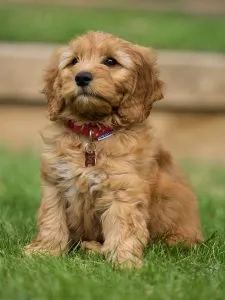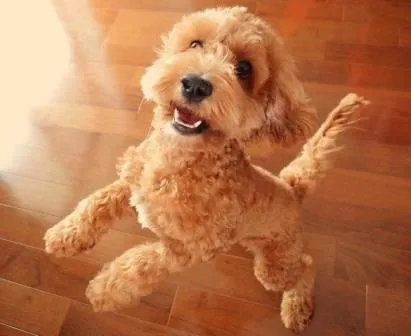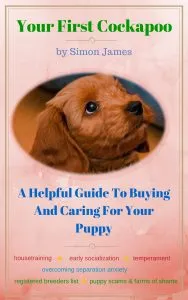Toilet Training A Cockapoo Puppy
…or newly adopted Cockapoo can seem daunting and often is frustrating.
The good news is, many puppies and Cockapoos can be housetrained in around two weeks, as long as the owner has the discipline to stick with a good, positive toilet training programme.

I’ve summarised the most important points below:
- Give him as many opportunities you can manage for him to get it right. It really is that simple! The more times he is rewarded for going to the toilet in the right place, the quicker he will learn.
- It’s equally important that you must never punish any mistakes that he makes during this learning time. If he thinks you are going to punish him then you’ll only confuse and worry him and the training will take much longer.
- Find a place you can keep your Cockapoo where it’s okay for ‘accidents’ to happen – but this is only for brief times when you cannot supervise him during training. For example, an indoor kennel or crate or an area penned off in the kitchen (baby gates work well). It has to be a relatively small area, which will discourage him from going to the toilet there. Place his bedding and water in his safe area and also use this space to feed him in. (Please note: if a Cockapoo or puppy is shut in an indoor kennel or pen for long periods of time, this can become a serious welfare issue and is not something that we recommend.)
- First thing in the morning, take your Cockapoo outside, stand with him and wait for him to go to the toilet. When he ‘goes’, give him lots of praise as he finishes (being careful not to interrupt what he is doing) and give him a treat. He should need a wee and a poo, so wait for him to do both.
- When he has gone to the toilet, you can take him back inside and have a play or cuddle. Let him have full access to the room that you are in – but only as long as you can give him your full attention and watch him – otherwise return him to his safe area.
- Take your Cockapoo out every hour on the hour from morning to last thing at night, to give him the opportunity to go to the toilet. You will also need to do this after exercise or play and after meals.
- When he goes, praise and reward him with a favourite treat (and write down the time of day that he went and what he did). If you keep a note of this every day, you will find that a pattern of when he goes takes shape. You can then use this to predict when he’ll need to go to the toilet. After about a week you shouldn’t have to take him out as often as every hour.
TIP: There will be times you can’t watch him, so place him in his safe area with a chew toy. It’s kinder to put him in his den area when you cannot watch him, than him sense your disappointment if he toilets in the wrong place.
When ‘accidents’ happen
There will be accidents. You must be prepared for this.
Remember Humans take at best three or four years to get this right; dogs take only two or three weeks!
It’s important to clean up any spray or odour left by accidents. Try cleaning the area with a one part non-biological washing powder / four parts water, or a branded product. This will take away any smells and stains. Make sure you do not use cleaning products that contain ammonia, as this smells like urine to Cockapoos, and will encourage him to use the same spot again and again.
Don’t make a fuss – your Cockapoo has not done it on purpose. If he is still going in the wrong place, then it may be because you are not watching him carefully enough. If you can’t watch him, he should be in his safe area. It’s not fair to keep letting him get it wrong.
Calmly place him in his den, whilst you clear up the mess (well enough it doesn’t become a sniffing place), then let your Cockapoo come back out and it’s all forgotten.
Don’t make this housetraining mistake
If you tell your Cockapoo off when he has accidents you will only cause him to worry and be afraid to toilet anywhere near you. It’s a common training issue that he may accidently learn to go inside but out of sight, in order to avoid the owner’s telling-off he is expecting.
This behaviour can spiral as it makes it harder for you to praise and reward him for toileting correctly, in the right places, because he won’t want to do his business in front of you anymore.
Toilet Training a Cockapoo Puppy
Some puppies may be too young to hold on for too long, as their bladders may be too small to cope. If this is the case, then you will need to take him out more often until he is a little older.
If your Cockapoo poo has diarrhoea or soft, runny poo and needs to go very often, then you may need to change his food, so it becomes more solid. Ask your vet for advice about this. Infact, if toilet training problems aren’t resolved in a few months, ask your vet to check your Cockapoo hasn’t got a medical condition that is behind the accidents.
Remember, some young puppies find it very daunting to toilet outdoors. They have developed a preference for, certain types of indoor surfaces during early accidental socialisation with their early environment.
Summary
- Make it easy for him. Make the effort to take him outside as often as you possibly can to give him the greatest opportunity to toilet in the correct place.
- Don’t leave him unattended for too long because he will pee when he sees you in excitement.
By rewarding your Cockapoo at the right time and ignoring mistakes, your Cockapoo will soon get the idea and be ‘accident’ free in no time at all. - If you put him in his indoor den or in your bedroom overnight, he’ll let you know when he needs to go out and this will help speed up the process.
- Find a friend – having a fully vaccinated, friendly older Cockapoo to visit and ‘show him the way’ can be very helpful and speed up the process.
Good Luck!
See Cockapoo Poo


